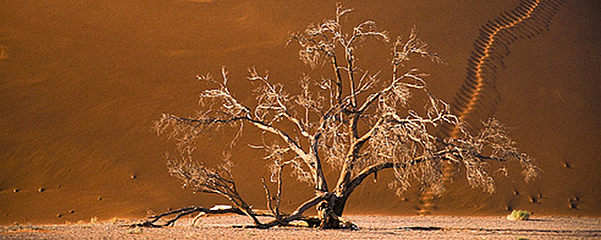Namibia

Of the great colonial adventures in Africa, Namibia was one of two major territories annexed by the Germans, and the one that felt the deepest impact of that country on its natural and cultural heritage. Everywhere you go in Namibia the flavor of German influence lingers, from the great lager beers to the stolidly permanent architecture, to the determinedly perfect road system that is probably the most valuable legacy left to the independence of this huge but ill defined nation.
What does define Namibia is desert. From what is often jokingly referred to as the 200-mile deep beach of the Skeleton Coast to the brilliant red dunes of the Sossusveli, it is the infinite variety of the arid Namib Desert that gives both feature and a name to this fascinating country. It is a deeply cultural destination too, with tribes like the Ovambo, the Kavango, the Herrero/Himba, the Damara and the Nama who all to varying degrees remain true to their cultural traditions.
Mostly Namibia is a touring destination. It enjoys with fantastic roads, small but clean, safe and well ordered cities, and a selection of far flung destinations to please the most demanding outfield traveler, and of course with everything in between to make the long journeys worthwhile.
Travel To & Within Namibia
Flights To Namibia Hotels In Namibia Hostels In Namibia
Why Travel To Namibia
Namibia may not stand out as a wildlife destination but in fact the country boasts one of the best big game conservancies in the sub-region: Etosha Pan National Park. Situated in the north/central region of the country, en-route towards northern Botswana, it is a uniquely interesting park with a well-earned reputation for throwing up surprises and never failing to impress.
To the east the Skeleton Coast is a unique eco-region of hot dune desert abutting the cold southern Atlantic. The result is a unique weather phenomenon that pushes morning fogs deep inland that allow for the survival of a rich variety of hardy desert flora and fauna.
In the south the Namib/Naukluft National Park is another hyper-arid region with a surprising diversity of unique fauna. The park is the largest of its kind in Africa, and although filled with interesting wildlife it is also famous for its vast and haunting desert landscapes.
The dry mountain region of the Waterberg, and the extensive Fish River Canyon, the second largest in the world behind the Grand Canyon, are NamibiaÂs hiking destinations, and although hardly alpine in aspect or texture, the rugged beauty of both locations is worth the sweat and grime to witness and explore.
Travel Facts
Quick Facts Transport Where To Go & What To Do… Climate & Geography History & Culture
When to Visit Namibia
Namibia has a fairly typical desert climate with extreme summer daytime temperatures in the central region that can just as easily plummet at nighttime to sub-zero. This can vary in the northeast where the climate tends to sub-tropical, but on the whole the cool winter months between May and September are the best times to visit this arid but beautiful country.
Travel Warning
Anywhere along the border with Angola and within the Capri Strip region in the north is worth avoiding due to insecurity that for a variety of reasons has flared periodically.
Otherwise Namibia is a safe and well-ordered destination with no particular threat to tourists or traveler beyond the ordinary. Street crime is significantly less than South Africa, but the influence of that country is unavoidable, so the usual rules of common sense in your day to day deportment, particularly in urban areas, is advisable.
HIV/AIDS is not as great a problem in Namibia as it is elsewhere in the region, and excellent heath facilities are available in the main centers.